I first met Andrew Feldman at PASIC in 1981. For several years beginning in the late 1970s he manned a small booth at the conventions, and advertised his sticks and mallets in the classifieds at the back of Percussive Notes. I bought a number of bass drum beaters and tam tam mallets from his display that year. At first I was attracted simply by the gorgeous materials and impeccable workmanship in all of his products, but I later found there were good acoustic reasons for everything Andrew did.
Following that convention I was able to begin an association with Andrew that lasted for around six years. I made regular trips to his workshop, which was housed in the basement of his parents’ home in Clifton, NJ. We collaborated on many interesting projects – everything from drum sticks and timpani mallets to claves and castanets.
I found an example of Andrew’s work before I actually made his acquaintance. Harvey Vogel had a small display area in his lobby at Lone Star Percussion in Dallas, TX where I noticed one pair of snare drum sticks – a simple copy of the Vic Firth General model – but crafted from purple heart wood and with the most impeccable lathe work and finish. I bought them instantly and soon after began to think of other designs I wanted to have made at the same level of quality and in the same beautiful hardwood. Purple heart quickly became my wood of preference for many types of sticks, mallets, and other kinds of equipment. It has a beautiful look and feel, with a substantial weight in between hickory and ebony that perfectly suits my playing style.
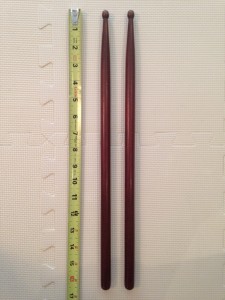
The first project I brought to Andrew was a snare drum stick design based on a model used by Charles Owen, originally shown to me by Mike Rosen. Andrew’s version of this stick, made first in purple heart, was spectacular, and had a balance and feel I had not experienced with any other drum sticks.
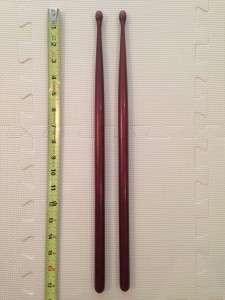
He made several sets for me, including a very heavy pair in ebony. I still use these sticks a great deal, and they formed the basis for the BBSD model now available in Honduras rosewood from Malletech.
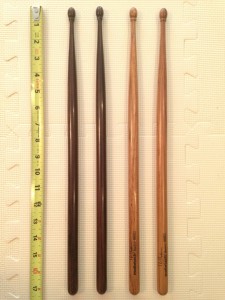
I later designed an extra-large drum stick for use on my big Cooperman rope drum. We again used purple heart, as well as some exceedingly dense hickory that Andrew had found at a local lumberyard.
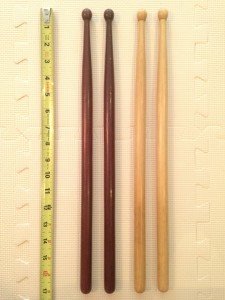
Additional designs followed, including versions of the standard 5A and 1S sizes, again in dense hickory and with Andrew’s usual meticulous craftsmanship. Every item he made for me was accompanied by highly detailed specs, including weight in grams, pitch in cents, and exact length and width. Of course every pair of sticks or mallets was precisely mated in all of those parameters.
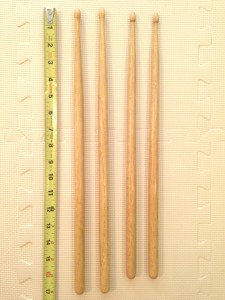
At one point I asked if it might be possible to duplicate, in wood, the hollow aluminum drum sticks that had been designed and manufactured by Fred Hinger. Andrew had studied with Hinger at The Manhattan School of Music, and so he was intimately familiar with Hinger’s products and concepts. He was able to create a hollow shaft design, and somehow work out how to produce it on his lathe. After some experimentation, I settled on a design with hollow maple shafts (5/16” bore), a bored tip made of bubinga, and a solid butt end made of purple heart. The configuration of woods gives the stick, which is symmetrical, a balance slightly weighted toward the butt. Hinger made his aluminum sticks in three sizes, and I asked Andrew to model our versions on the dimensions of Hinger’s medium and large models. These sticks can produce a huge sound on a snare drum or tom, and I use them when playing my piece Mudra, for example.
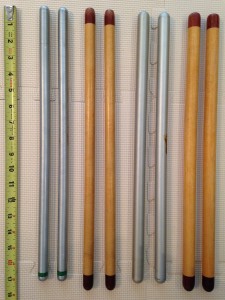
Andrew went on to apply this hollow shaft design to an entire line of timpani mallets, just as Hinger himself had used the hollow aluminum sticks as handles for his timpani mallets. We tried a variety of hardwoods in this context too, and found that both cherry and mahogany worked particularly well.
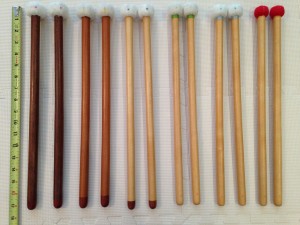
Some of the other members of Nexus also began to request special designs from Andrew. Robin Engelman, Russ Hartenberger, and, in particular, John Wyre commissioned him to make special timpani, bass drum and gong/tam tam mallets. Wyre was accustomed to using very long – usually 19” – shafts for his timpani sticks, and he tried many combinations of wood types for shafts and butts, with various bores, tapers and diameters.
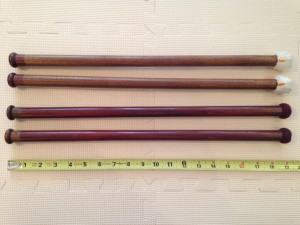
I personally found the bored wooden shafts a bit too lightweight for most timpani playing, and I have used them more often in other applications. My preference for timpani mallets has always been bamboo, and Andrew was a master in this medium too. He made numerous sticks for me over the years, always creating perfectly mated handles using the extra heavy bamboo that I prefer.
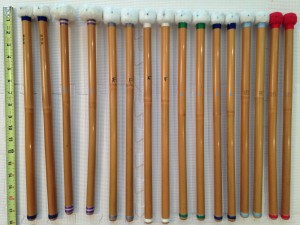
When I was an undergraduate at the Eastman School of Music I learned the basic principles of timpani mallet construction – first from my teacher William Street, and then in more detail from classmates Bill Platt and Bill Cahn, both of whom used Fred Hinger’s approach to handling felt and stitching. Partly for this reason I felt very at home with Andrew’s mallet-making style, and I sometimes asked him to make updated versions of sticks and mallets I had made for myself previously. I knew his craftsmanship would be superior to mine, and I expected some new and interesting twists to my own ideas. I was never disappointed. For example, during my sophomore year at Eastman I had made four bass drum mallets specifically to use in a performance of Stravinsky’s The Rite of Spring. Two of them were a pair on rather long bamboo shafts, and I wanted Andrew to make something similar with purple heart wooden handles
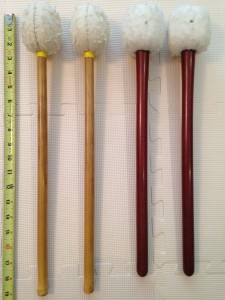
During the 1960s it was a kind of pilgrimage for students to make an annual trip to New Jersey to visit the Hoboken Bamboo and Rattan Works. In those days the company maintained an enormous warehouse on the docks of the Hudson River, and the workmen would willingly open entire bales of bamboo so that we could comb through hundreds of stalks to find the perfect ten or twenty that we wanted for mallet handles. It was a good six-hour drive one way from Rochester to Hoboken, but it was always an adventure and something I looked forward to doing almost every year. Most of the mallets I made at that time – around 1967/68 – still survive. I continue to use them, and the Hoboken bamboo hasn’t split or cracked, even after more than forty years.
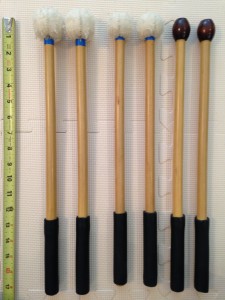
Sometime around 1983 Charles Owen gave me an old pair of xylophone mallets he said were George Hamilton Green models. The sticks had short, solid wood handles, which were beautifully turned. One of the mallets had broken at the neck just below the mallet head, but the other one was intact.
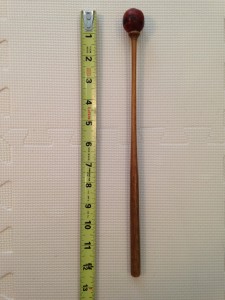
I was curious how wooden handles would feel on the xylophone, and so I took the old mallets to Andrew and asked if he could duplicate the shafts. Although the original mallets appeared to be made of oak, we tried a variety of woods for our copies, including walnut, bubinga, maple and purple heart. We also tried lengthening the shaft, as the original length (12” including the ball) felt a bit short to me. After Andrew made the shafts, I went to Malletech and asked for rubber balls that matched the original as closely as possible. At that time Owen’s mallets were probably 70 years old, and the rubber was badly deteriorated. Malletech gave me rubber balls in two hardnesses to experiment with, and I tried both types on all of the shafts Andrew had made. Even though his work on these sticks was spectacular, none of them felt or sounded good to me on a xylophone, and I finally abandoned the project. We know George Green primarily used rubber mallets with 13” rattan handles for most of his career, but still I would like to know how this wooden type came about, and when he might have used it.
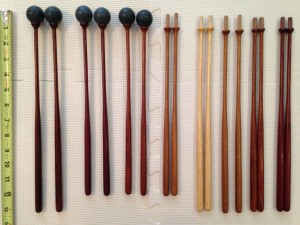
During the 1984/85 season NEXUS made several extended tours to Europe and Asia. Everyone took advantage of these travels to find and purchase a variety of instruments. In particular, our stops in China, Japan and Korea resulted in a major growth in my own collection of gongs, small tam tams and cymbals. At this time we still included improvisation as a major element on our programs, and I wanted to incorporate as many of these instruments as possible in my setups. It was a challenge to make the kinds of sounds I wanted on a large assortment of metal instruments, and so I asked Andrew to create some mallets based on a few traditional oriental designs. We decided on oak, maple and walnut for the handles.
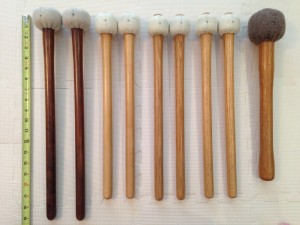
I have several large rin (Japanese temple bowls) – traditionally played with special beaters made from big wooden dowels with fine suede leather wrapped around the upper half of the stick. I wasn’t satisfied with the ones I could purchase in Japan, and so Andrew was able to make exquisite copies using purple heart and padauk.
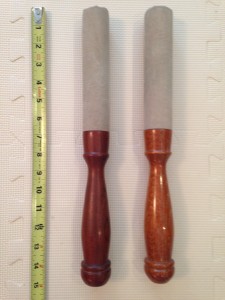
In 1973 the composer Steve Reich wrote a percussioin quintet called Music for Pieces of Wood. Russ Hartenberger and I were regular members of Steve’s ensemble at that time, and we were involved in the development and premiere of the piece. At first Steve was unsure about the instrumentation, and we experimented with crotales and almglocken before he settled on tuned claves. He bought four sets made by the Latin Percussion company (2 sets of “Standard” claves – solid dowels, and 2 sets of “African” claves – with a hole bored through the center of the struck clave), and one pair of traditional Mexican rosewood claves. Steve tuned the claves to specific pitches using a belt sander (the procedure is similar to tuning a marimba bar).
A few years later NEXUS added Music for Pieces of Wood to our concert repertoire, and then recorded it in 1982 on our LP record Changes. At that time we played a set of claves that Russ Hartenberger purchased and tuned, made from the same Latin Percussion and Mexican types Reich himself had used.
NEXUS did a great deal of international touring in the 1980s, and we performed in many kinds of halls and venues. Music for Pieces of Wood became a staple on our concerts, often placed as the opening work on the program. We were able to memorize the piece and perform it front and center, giving to the audience an immediate and dramatic introduction of the group and its members. Many percussion ensembles have come to appreciate this aspect of the piece, not to mention its portability and small stage footprint.
Performing this work repeatedly, both in NEXUS and in Steve Reich’s ensemble, I found myself wishing for clearer pitches and stronger projection from the claves. It occurred to me that the relatively soft wood used by Latin Percussion could be improved on, and around 1985 I took the idea to Andrew Feldman. We began a project to make Latin Percussion style claves using much denser woods. As we experimented, we found that harder woods, such as purple heart or bubinga, besides producing a significantly clearer and brighter tone, automatically produced higher pitches than Latin Percussion’s chosen woods when made in similar dimensions. We also discovered that the beater clave in these sets should be made of a slightly softer wood than the “anvil” clave. Eventually I found myself with dozens of claves made from several types of wood, and placed at different transpositions of the original score. I selected the version that sounded best to my ear, which turned out to be “anvil” claves made from purple heart and beaters made from bubinga, with the “key” of the piece transposed up a whole step to D#. This became the definitive set of claves still used by NEXUS to the present time.
Soon after we began using these claves in performance Steve Reich heard us play Music for Pieces of Wood, and within a few months he had his own set from Andrew, which the Reich ensemble continues to use. Steve has used tuned claves effectively in more recent works as well, notably in his theatre piece The Cave. All of them were made by Andrew Feldman.
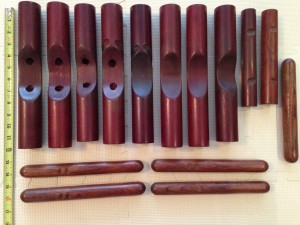
In 1986 Steve Reich & Musicians made a tour in Europe that included performances in Madrid, Spain. I used my free time there to visit several music stores, with the idea that I might find some nice castanets. I was completely unprepared for the enormous variety that I discovered – there were literally dozens of distinct types based on shape, size and material. I could have filled my suitcase (and depleted my bank account), but I limited my purchase to six pairs, and when I got back, took them all to Andrew. I had no training in traditional castanet technique, so in order to use them in the orchestra, or any other application, I needed them to be mounted machine-style, or on handles. Andrew had some interesting ideas about this, but first he cleaned and buffed every castanet. The next time I saw them, each castanet had been transformed into a wooden gem, reflecting the high standards that Andrew expected from every job – whether the work was his or someone else’s.
He proceeded to create a mounting system that allows castanets attached to a handle to sound freely, without being played against a leg or hand. Although the playing technique takes some getting used to, the sound is far superior, closer to the natural sound of castanets played with fingers in the traditional manner. I had specified my favorite wood, purple heart, be used for the handles.
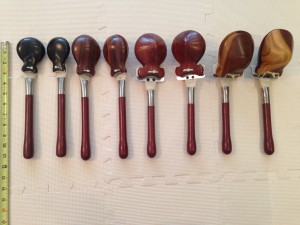
Two other pairs were mounted on oak handles, as I had asked to have the bases of the handles threaded so they could be attached to cymbal stands. One of these pairs is made from cast aluminum – an idea that my colleague Bill Cahn came up with and then had fabricated in Rochester, NY.
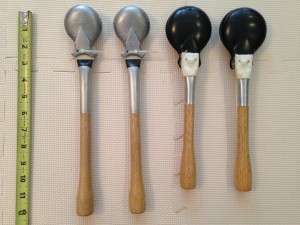
The most unusual castanets I found in Madrid were enormous – nearly six inches in diameter. I had no idea such things existed, and to this day I wonder about the size of the hands that can hold them. I couldn’t imagine playing them on handles of any kind, so I asked Andrew to mount them so they could be played with the hands or with mallets. His mounting system is ingenious. I have used these castanets in various contexts, and Ellen Taaffe Zwilich included them in my part to a concerto she composed for NEXUS entitled Rituals. When Ellen asked what to call them, I suggested the term “contra-bass castanets”, which is the indication now written in the published score.
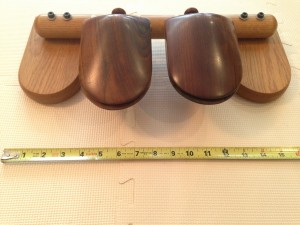
By the end of the 1980s Andrew had become disillusioned with the percussion product world, and perhaps with the entire music business. His perfectionism toward his craft, and his very high expectations of excellence from everyone else – manufacturers and performers alike – led to inevitable disappointment and a feeling that the superior quality of his products went underappreciated. He finally decided to go in other, more lucrative career directions. While we were working together, I always invited him to concerts and events when I was in New York City. The last time I saw him was in 1993 – backstage at the Brooklyn Academy of Music – following the US premiere of Reich’s The Cave. He had gotten married, moved to Brooklyn, changed his first name to Avrohom, and was working for a computer firm. He seemed happy and at ease.
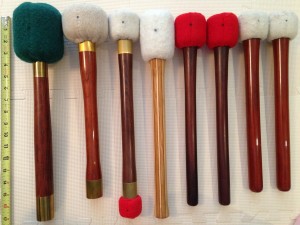

Wonderful story! I freelance in N.Y.C. all through 80s and some of the 90s but was mostly on tour from 1980-2000 . Feldman timp, B.D.mallets were always part of my setups. Have a pair of his castenets as well. All still used to this day. Great feel great response and craftsmanship! ! Wish he was still in the business. Thanks Mr.Becker for sharing a pc.of mallet making history. Great collection of Feldman mallets! Quick story! On tour back in the 80s in Memphis I was staying in the same hotel as Nexus and traveled in elevator with you guys to… Read more »